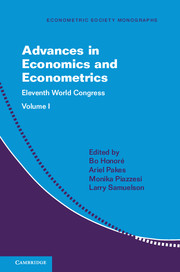Book contents
- Frontmatter
- Contents
- Contributors
- Editors' Note
- 1 Dynamic Mechanism Design: Robustness and Endogenous Types
- 2 Learning, Experimentation, and Information Design
- 3 Dynamic Selection and Reclassification Risk: Theory and Empirics
- 4 Discussion of “Agency Problems”
- 5 Recent Developments in Matching Theory and Their Practical Applications
- 6 What Really Matters in Designing School Choice Mechanisms
- 7 Networks and Markets
- 8 Econometrics of Network Models
- 9 Networks in Economics: Remarks
- Index
5 - Recent Developments in Matching Theory and Their Practical Applications
Published online by Cambridge University Press: 27 October 2017
- Frontmatter
- Contents
- Contributors
- Editors' Note
- 1 Dynamic Mechanism Design: Robustness and Endogenous Types
- 2 Learning, Experimentation, and Information Design
- 3 Dynamic Selection and Reclassification Risk: Theory and Empirics
- 4 Discussion of “Agency Problems”
- 5 Recent Developments in Matching Theory and Their Practical Applications
- 6 What Really Matters in Designing School Choice Mechanisms
- 7 Networks and Markets
- 8 Econometrics of Network Models
- 9 Networks in Economics: Remarks
- Index
Summary
In recent years, many developments have been made in matching theory and its applications to market design. This paper surveys them and suggests possible research directions. The main focus is on the advances in matching theory that tackle market design problems in practical markets where the classical theory is inapplicable. Specifically, I discuss the recent theory of matching in large markets and “approximate market design,” and a new theory of “matching with constraints,” as well as their applications.
INTRODUCTION
Matching theory has made considerable progress since the seminal theoretical contribution by Gale and Shapley (1962) and its economic application by Roth (1984). The theory has been used to guide designs of medical match (Roth and Peranson, 1999) and other entry-level labor markets (Roth, 2002), school choice (Abdulkadiroğlu and Sönmez, 2003), course allocation in education (Sönmez and Ünver, 2010; Budish and Cantillon, 2012), and organ donation (Roth, Sönmez, and Ünver, 2004, 2005, 2007), just to name a few examples.
Theory has been put to practical use with much success, but the interaction between theory and practice is not unidirectional. On the contrary, as more practical applications have been found, the accompanying experiences have also uncovered limitations of existing theory. This has opened up opportunities for researchers to not only deepen the analysis of existing models but also generalize the standard model or introduce new models, thereby enabling us to address challenges that arise in applications.
Much of recent development in matching theory has been guided by our desire to solve practical problems with features that are absent from the standard model but are important in practice. New models that incorporate some of these features lead to sharp predictions while still being general enough to enrich our understanding of the markets beyond one specific example.
This paper describes recent developments in matching theory and its applications. The survey by Abdulkadiroğlu and Sönmez (2013), based on their lectures at the lastWorld Congress, offers an excellent introduction to the basic models as well as applications. Thus, in this piece, I will focus on several specific topics that represent the kind of recent interaction between theory and practice I alluded to above. More specifically, my focus will be on how the features of some real markets deviate from the classical models, and how the theory has been modified or expanded to tackle these problems.
- Type
- Chapter
- Information
- Advances in Economics and EconometricsEleventh World Congress, pp. 138 - 175Publisher: Cambridge University PressPrint publication year: 2017
- 6
- Cited by



